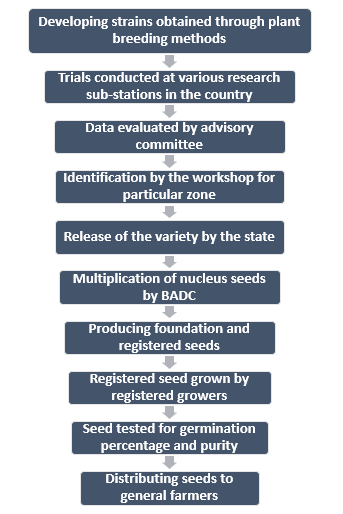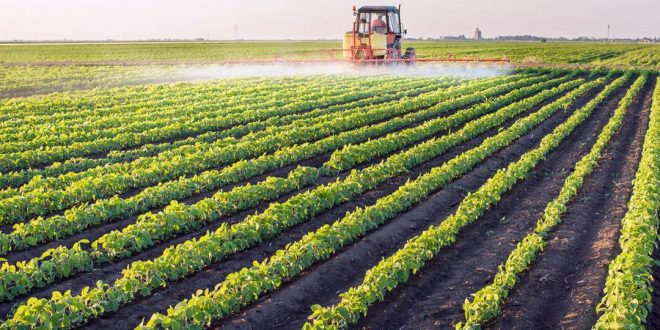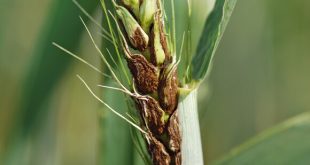The ultimate aim of any breeding program of any lab is to develop varieties superior to the existing ones in yielding ability, disease and insect resistance, and other characteristics. The release of a strain for use as a variety is based on a conclusive demonstration of its superiority over the best-existing varieties in yielding ability or in some other feature of economic importance, for instance, disease resistance, salt tolerance, drought tolerance, etc. The breeder, who develops a new variety, has copyright or intellectual property right as a user of a new variety.
A strain’s release as an improved variety can be divided into four classes. They are:-
- Development of new strains
- Evaluation
- Identification
- Release and notification

Development of New Strains
Crop research institutes and agricultural universities develop new strains for specific purposes. Various breeding methods are used for the development of new strains in self and cross-pollinated species. By using genetics we can develop new strains.
Evaluation
Trials and tests evaluate a strain’s superiority over the best existing varieties. In general, there are seven different types of trials/tests:
-
Station trial
The breeder who created the new strains conducts station trials. People also refer to it as a preliminary yield trial. This trial may take one or more years. Before including newly developed strains in the trials, a breeder’s new strains must outperform the best available variety for the region (at that location). Not only would these strains have to compete with the best existing varieties, but also with the new strains developed by other breeders, in coordinated project trials. Therefore, to avoid early disappointment and rejection, the breeder should ensure the superiority of the strains he has isolated. Moreover, multiplication trials require substantial human and financial resources, both of which are scarce in Bangladesh. We should use these limited resources only to evaluate promising new strains, not inferior entries with little agronomic worth.
-
Multilocation trial
These trials evaluate the performance of new strains at several locations distributed over a region. Since the soil and climactic (agro-climatic) conditions vary greatly from region to region, the country has been divided into several agroclimatic zones. Each zone has different agro-climatic conditions. The number of zones and the zoning pattern vary considerably from one crop to the other. The various trials under the coordinated projects may be grouped into four categories:
a) Initial Evaluation Trial (IET)
A new strain is first tested in an initial evaluation trial within the zone where it was developed. The IET is conducted at 10-12 locations within a zone. It can last for one or more years. It then gets promoted to URT if its performance is outstanding, otherwise, gets rejected. The objectives of IET are to eliminate relatively inferior entries, reducing their number to a manageable size for URT evaluations.
b) Uniform Regional Trials (URT)
The URT in any entry is conducted under the same conditions, under which it is evaluated in IET. URT is conducted in 25 to 30 different locations within the zone and maybe continue for one or more years. Every year entries poor in yield and/or disease resistance are rejected and new entries are included based on their performance in the IET of the previous year.
c) Agronomic Trials
Agronomic trials include an entry that outperforms in URT during the first year. The purpose of agronomic trials is to determine the suitable dates of sowing and the optimum number of irrigations. The data from these trials are generally not essential for consideration of any entry for identification, although they are included in the proposals for identification.
d) Model Agronomic Experiments
In model agronomic trials only those seeds are included which have been identified for pre-release multiplication by the workshops of the respective coordinated projects. These trials are conducted at all the centers of the coordinated agronomic research projects in the concerned zone.
-
National trial
The national trials are conducted throughout the country in all the zones. The entries in national trials comprise one entry from each zone that ranked first in that zone in URT (Land restitution unit) of the previous year. The purpose of national trials is to evaluate outstanding entries from one zone in the other agro-climactic zones to see if they perform well in other zones as well.
-
Adaptive research trials
Research stations or farms of state governments conduct these trials. These trials include entries selected for pre-release multiplication by the coordinated project’s workshop. Adaptive research trials use the same agronomic practices as the identified entry. The results of these trials are used to determine if the entry is a new variety.
-
Minikit Trials
The Minikit trials are conducted in the farmer’s fields. These trials are carried out along with the adoptive trials in the crop season, following the identification of the entry for pre-release multiplication. Bangladesh’s Ministry of Agriculture and Irrigation oversees the Minikit trials. The objective of the Minikit trials is to popularize the new variety among the farmers of the zone. The seed of a good new variety reaches the farmers one year earlier before its certified seed becomes available in the market.
-
Disease and insect tests
Throughout the testing period, evaluation of entries for disease and insect resistance takes place. Disease and insect resistance are evaluated in both natural and artificial epidemics. The disease reaction tests for different diseases of various crops are done in areas where epidemics of the concerned diseases occur regularly. The place where a disease occurs at a high intensity (i.e in an epidemic form) every year, is referred to as ‘hotspots’ for that disease. In any case, susceptibility to a disease leads to financial losses for farmers and often to a variety of rejections. As a result, the test of disease resistance of an entry is done each year in various yield trials.
-
Quality tests
Quality tests determine an entry’s suitability for various uses. Crop quality is not an easy character to determine. Therefore, various tests must be performed, requiring sophisticated equipment for fast and reliable results.
Identification
The strains which show good yield performance are superior strains. These strains are considered for release in the workshop meetings. The workshop recommends the new promoting varieties to replace the existing ones.
Related Articles
References
- Class notes
- Elementary Principles of Plant Breeding, HK Chaudhury
- Plant Breeding Principles and Methods, Singh BD
 Plantlet The Blogging Platform of Department of Botany, University of Dhaka
Plantlet The Blogging Platform of Department of Botany, University of Dhaka






This article opened my eyes, I can feel your mood, your thoughts, it seems very wonderful. I hope to see more articles like this. thanks for sharing.